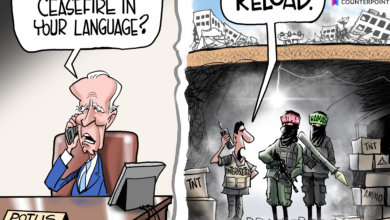Defense Issues Weekly – week of May 12th, 2013
A satellite photo, with markings, of China’s underground submarine base at Jianggezhuang near Qingdao in northeastern China. The base is super-hardened against air and missile attacks. While this 2000s photo depicts only a Han and a Xia class submarine present outside the base, more submarines were based inside. This is the base from which Chinese SSBNs going on deterrence patrols against the US probably operate. Photo source: DigitalGlobe/”China’s Nuclear Forces,” Imaging Notes, Winter 2006, p. 25.
DOD releases report on China’s military power
On Tuesday, May 7th, the DOD released its annual report on China’s military power and defense policies. The report is much longer and more detailed than last year’s, which was dramatically shortened to just 10 unclassified pages, ostensibly to cut costs while costing more to prepare than 2011’s much longer report.
This year’s version, at 92 pages, gives a great amount of information – both verbal and graphic – on China’s military power, the dispersal of its troops and bases, and the ranges of its missiles. However, while analysts consider it a significant improvement over last year’s document, this year’s still significantly understates China’s military power.
For example, it claims that China’s air force still flies, for the most part, obsolete 2nd- and 3rd-generation fighters and that modern fighters are still a minority in its fleet. This is factually incorrect: the J-7 and J-8 fighters which the report refers to, at 569 aircraft, are now less numerous than the PLAAF’s modern fighters, which number 587 (J-10s, J-11s, Su-27s, Su-30MKKs, JH-7s). Moreover, modern aircraft’s share of the PLAAF’s fleet will only grow overtime: 70 additional J-11s as well as 24 Su-35s are on order and an unknown number (but possibly hundreds) of 5th generation stealthy J-20 and J-31 fighters are poised to join the fleet.
Moreover, the J-7 and J-8, despite their age, are actually superior to the costly F-35 now under development: they can fly much higher and faster and are more agile. The J-7 has a max altitude of over 57,000 feet and a top speed of Mach 2; and its light weight and low wingloading ratio make it a superior dogfighter to the F-35. The J-7 can defeat an F-35 easily by simply refusing to be a straight, level target. In Vietnam, MiG-21s (on which the J-7 is based) routinely defeated American F-4 fighters.
The report also significantly understates China’s nuclear arsenal and submarine fleet. It claims that only 3 modern Jin class SSBNs (“boomers”) are in service, even though there were that many as early as 2007/2008; China actually has 5 in service with a sixth one under construction. This is intended to replace the old Xia class SSBN, still in service, which, together with the Jins, gives China a 6-boat SSBN fleet and thus already a continous at-sea nuclear deterrent – which the report falsely claims China doesn’t yet have.
Nonetheless, the report does warn of a large ongoing expansion of China’s sub fleet – it plans to deploy a total of 8 Jins and 6 Shangs (other sources say 6-8) and is developing a new SSBN (Type 096) and attack submarine (Type 095, Tang class). Two Tangs have already been deployed, and these are much quieter than China’s previous, noisier submarine classes.
This makes mockery of Adm. Jonathan Greenert’s recent claim that “we own the undersea domain” and that “the Chinese are not there yet”, especially in light of the fact that the USN can only supply 10 attack submarines to combatant commanders when its own minimum need is 16, and the fact that the USN’s anti-sub-warfare skills and equipment have atrophied.
The report claims that the range of the JL-2 SLBM is only 7,200 kms and can reach only parts of Alaska. But the JL-2 actually has a range of 8,000 kms according to multiple Chinese and Western sources (including SinoDefence and GlobalSecurity), and the report’s map deceptively shows the JL-2’s range as if it were launched from Chinese mainland. (p. 81)
But the JL-2 is a submarine-launched missile, meaning China can launch it from anywhere on Earth. Even with a 7,200 km range, the JL-2 could reach Los Angeles if launched from 160 degrees east, well west of Hawaii. With an 8,000 km range, it can reach LA from a position just east of 150E, i.e. just east of Japan.
Similarly, the report wrongly claims that the DF-21 land attack and anti-ship ballistic missile’s range is only 2000 kms. In fact, the DF-21A, the longest-ranged land attack variant, has a range of 2,700 kms, and the DF-21D ASBM, 3,000 kms – stretching out almost to the Second Island Chain, including Taiwan. This means any surfance ship within 3,000 kms of China’s coast can be sunk.
The report admits, for the first time, that China is testing a DF-41 multiple-warhead ICBM, but does not include it on its missile range map nor acknowledge that the DF-41 may very well already be deployed (it was first photographed in 2007). It also claims the DH-10 land-attack cruise missile has only a 2,000 km range; in reality, it’s 4,000 kms, more than enough to reach Guam.
Last but not least, Richard Fisher, a Chinese affairs expert with the International Assessment and Strategy Center, has criticized the report for failing into account China’s supply of transporter-erector-launchers for North Korean KN-08 ICBMs.
General Dempsey bows to the Muslim Brotherhood
An Army Lieutenant Colonel currently lecturing at the Joint Forces Staff College has been denied promotion and faces possible dismissal following an intervention by Gen. Martin Dempsey.
Dempsey, as chairman of the Joint Chiefs, ordered an investigation after Muslim Brotherhood affiliated organizations filed a complaint with the DOD urging LTCOL Matthew Dooley, a combat veteran and West Point graduate, to be punished after LTCOL Dooley was found to teach his students about the dangers of radical Islam. The National Defense University, which oversees the college, has not found any fault with Dooley’s teachings.
Dooley, a West Point graduate, has 6 combat deployments and 18 years of military service under his belt. An Army promotion board unanimously recommended him for promotion to battalion command, praising his career and accomplishments. However, in 2011, a student of Dooley’s complained about his supposedly offensive teachings to the DOD, and General Dempsey was informed. Dempsey, a political general, personally ordered that Dooley be denied promotion and that an investigation aimed at throwing him out of the military be initiated. The investigation has reached its predetermined conclusions, claiming that he was a “poor officer” and resulting in his firing.
The Washington Times has narrated the story in more detail here.
France makes defense cuts, retains ambitions
The French government announced some painful cuts to the military last week, as it looks to defense spending to cut France’s massive budget deficit.
While the cuts will not be as deep as in other countries – defense spending will be frozen in nominal terms (and cut slightly in inflation-adjusted euros) – there will be a cut of 24,000 personnel, mostly from the defense ministry’s administrative staff, but also a reduction of the number of troops deployable abroad from 30,000 to 15,000-20,000. The Navy will have only 15 “first-rang frigates” rather than 17, and the fleet of fighters for the Air Force and Navy combined will be cut sharply, from 300 to 225. France will also not resume production of fissile material for nuclear weapons.
Moreover, the government has delayed the delivery of new weapon systems, which, in the long term, will cost more than if they were to be delivered sooner. The decisions, outlined in the new White Paper on National Defense, will form the basis of the Law on Military Procurement for 2014-2019 and for the defense budgets for those years.
The defense cuts have been criticized from both the Right and the Left. Far-left politician Jean-Luc Melenchon has denounced them as weakening the stature of France; far-right leader Marine Le Pen has called for defense spending to be ring-fenced and kept permanent at 2% of GDP. Mainstream right-wing UMP (neo-Gaullist) party politicians have also expressed worries. So have retired generals, who estimate that with just 15-20K troops deployable abroad France will have little capacity to intervene abroad in defense of its national interests and be only a minor contributor to coalition operations alongside the US, Britain, or other allies.
Under the plans, announced recently in detail by Defense Minister Jean-Yves Le Drian at the Ecole Militaire in Paris, the French military will avoid the deep cuts in programs imposed on other Western militaries. However, it is already a small military by American standards. Furthermore, it is estimated that 20,000 deployable troops won’t be enough to make a significant contribution to allied operations. The same can be said of its plan to cut the combined Air Force – Navy fighter fleet to just 225 aircraft, down from 300 today.
Moreover, there is a basic criticism of the White Paper: that it is being made to fit the budget, rather than the other way around, i.e. some critics claim that the government is putting the cart before the horse by making the strategy fit the budget. This is the same mistake that the governments of the US, Britain, Canada, Australia, Germany, Italy, and other countries have made, which has made them less secure.



